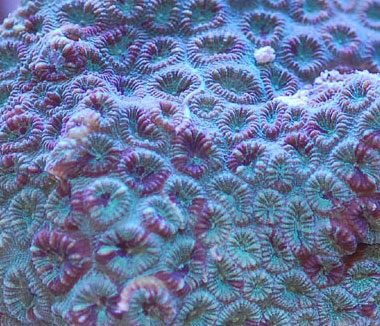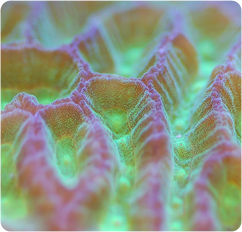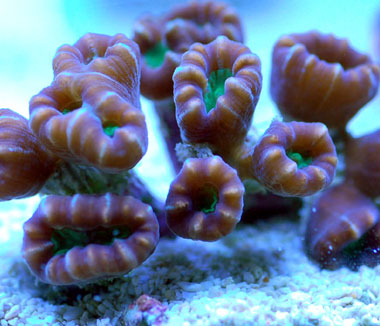|
Family Faviidae - Fluorescing Corals
A Family of Beautiful and Hardy Corals, Many of which Fluoresce 
Behind Acroporids, faviids are the second largest family (in terms of species) of scleractinians or stony corals. Unlike Acroporids, faviids are some of the easiest stony corals to keep. The Faviidae family represents some of the hardier, more light-tolerant corals available to hobbyists (especially species from the genus Favia, which includes corals commonly referred to as moon coral, pineapple coral, brain coral, closed brain coral, and star coral). They are attractive corals known for their striking fluorescence, and they make a great addition to most reef tanks. With 25 genera from which to choose, chances are there is a faviid right for almost every aquarium setting.
In the wild, faviids can be found in both the Atlantic and the Pacific (two genera-Favia and Montastrea-are found in both oceans). Faviids can also be found in aquaria around the world. The most common genera of faviids amongst aquarists include Caulastrea (e.g. Trumpet Coral), Cyphastrea (e.g. Scrolling Brain Coral), Diploastrea (e.g. Moon Brain or Closed Brain), Echinopora (e.g. Chalice Coral, Hedgehog Coral), Favia (e.g. Pineapple and Moon Coral) Favites (e.g. Closed Brain, Pineapple and Moon Coral), Goniastre (e.g. Honeycomb Coral), Leptoria (e.g. Maze Coral), Oulophyllia (e.g. Closed Brain Coral, Ejection Seat Coral), and Platygyra (e.g. Closed Maze Brain Coral).

Like so many corals, identification down to the species level of a living specimen is often difficult, if not impossible. To make matters more confusing, as can be seen above, the common names frequently overlap from one genus to the next. Luckily for the aquarist, the husbandry of faviids can be dealt with in very general terms given how tolerant most species are of a wide range of aquarium conditions—to wit: give them moderate reef lighting (all are symbiotic), moderate intermittent flow and good water quality.
Some faviids have long sweeper tentacles (especially those from the genera Favia, Favites, Oulophyllia, and Platygyra) and should be given sufficient space so as not to damage their neighbors. Species from the genus Leptoria are known to be somewhat less tolerant of higher nutrient levels, quite aggressive (defensively speaking) and very slow growing. Faviids from the genus Platygyra are also considered somewhat less tolerant and more prone to bleaching when stressed. Caulastrea species typically need indirect lighting and may be damaged by strong water movement.

All 25 Genera of Faviids
Astreosmilia, Australogyra, Barabattoai, Bikiniastrea, Caulastraea, Colpophyllia, Cyphastrea, Diploastrea, Diploria, Echinopora, Erythrastrea, Favia, Favites, Goniastre, Leptastrea, Leptoria, Manicina, Montastraea, Moseleya, Oulastrea, Oulophyllia, Parasimplastrea, Platygyra, Plesiastrea, and Solenastrea.
Published 27 May 2008. © Blue Zoo Aquatics
|